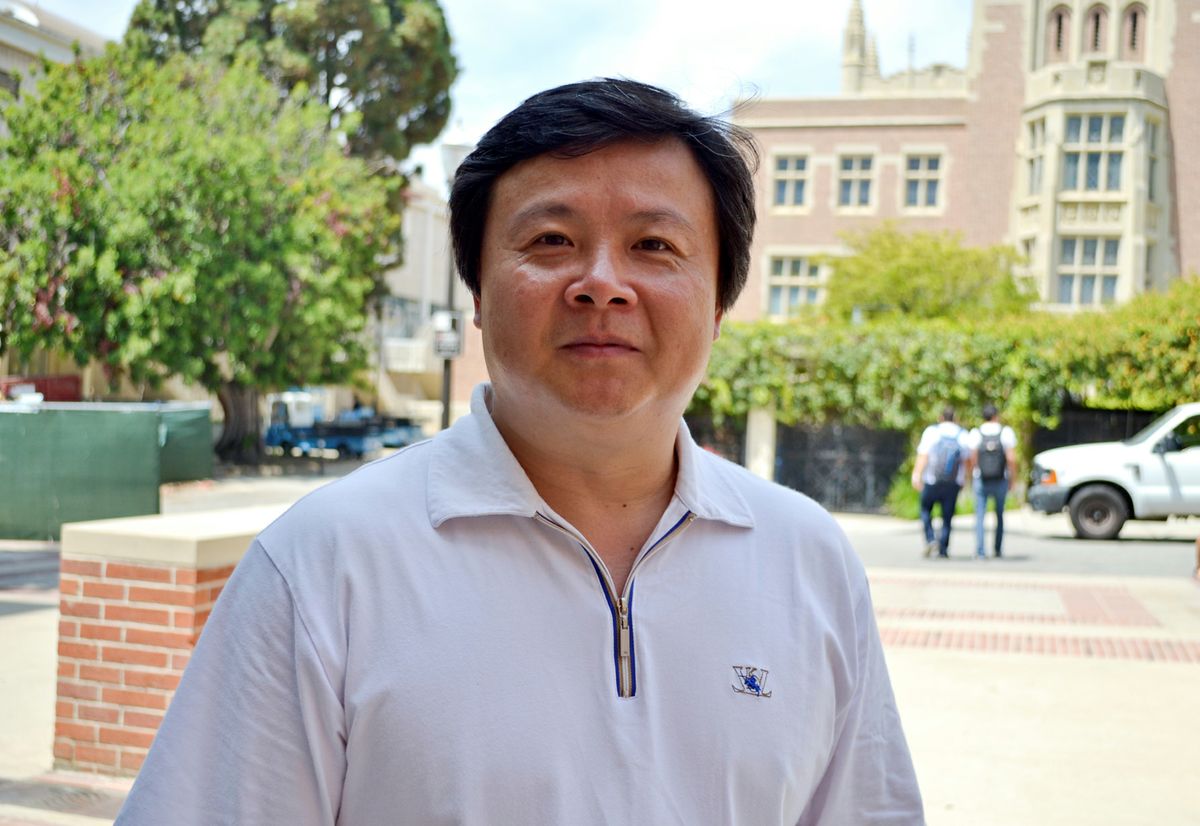 纯金属的形变样本(左);金属镁和碳化硅纳米颗粒组成的新型超强金属材料(右)。中央微柱的直径在4微米左右。
纯金属的形变样本(左);金属镁和碳化硅纳米颗粒组成的新型超强金属材料(右)。中央微柱的直径在4微米左右。 项目主要研究员、UCLA制造工程讲席教授李晓春表示:“过去有人提出纳米颗粒可以真正增强金属的强度,而且不会影响其可塑性,特别是与镁这种轻质金属结合尤其有效。但在我们之前,还没有哪个研究机构可以在熔融金属中注入分散的陶瓷硅纳米颗粒。”
项目主要研究员、UCLA制造工程讲席教授李晓春表示:“过去有人提出纳米颗粒可以真正增强金属的强度,而且不会影响其可塑性,特别是与镁这种轻质金属结合尤其有效。但在我们之前,还没有哪个研究机构可以在熔融金属中注入分散的陶瓷硅纳米颗粒。”
加州大学洛杉矶分校(UCLA) 亨利萨穆埃利工程与应用科学学院的研究人员带领团队成功研制出一种新型的超强轻质结构性金属。这种金属拥有超高的比强度和比模量,换言之,这种新型材料的刚重比(stiffness-to-weight)非常高。新材料是由金属镁和注入其中的密集且均匀分布的陶瓷硅碳化纳米颗粒组成。用这种材料制造的飞机、航天器和汽车重量更轻,因此燃料经济性也更高。
为了研制这种超强但轻质的金属材料,UCLA团队找到了一种方法,可以在熔融金属中分散纳米颗粒,并使其保持稳定。他们还研发了一种可扩大规模的制造方法,用以制造更多的高性能轻质金属。
UCLA制造工程讲席教授李晓春是Raytheon合作项目的主要负责人,他表示:“过去有人提出纳米颗粒可以真正增强金属的强度,而且不会影响其可塑性,特别是与镁这种轻质金属结合时尤其有效。但在我们之前,还没有哪个研究机构可以在熔融金属中注入分散的陶瓷硅纳米颗粒。
通过物理注入和材料加工的方法,我们可以向多种不同的熔融金属中均匀注入密集纳米颗粒,开创了提高金属性能的新途径,有助于应对当下社会面临的能源节约和可持续发展挑战。”
结构性金属指的是承担支撑任务的金属,多用于建筑和汽车之中。金属镁的密度仅为铝的三分之二,是最轻的结构性金属。碳化硅是一种超级坚固的陶瓷材料,常用于工业刀片的制造。研究人员在金属镁中注入大量直径小于100纳米的碳化硅颗粒,能够显著提升材料的强度、硬度和可塑性,以及高温下的耐用性。
用研究人员的话来说,这种注入碳化硅的新型镁材料具有“创纪录”的比强度和比模量,前者指材料在破裂前可以承受的最大重量,后者指材料的刚重比。这种材料还在高温下表现出优异的稳定性。
长久以来,陶瓷颗粒一直被视为提高金属强度的可行方法。不过,在过去,由于颗粒仅能做到微米级,注入后会影响材料的可塑性,因而一直未得到有效利用。
与微米颗粒相比,纳米颗粒不但可以增强金属的硬度,而且还能保持、甚至提升材料的可塑性。但这里有个问题,由于微小粒子间会相互吸引,纳米陶瓷颗粒很容易聚成一团,而非均匀分布在新材料中。
为了解决这一问题,研究人员将陶瓷微粒注入熔融状态下的镁锌合金之中。这种新发现的纳米粒子主要依靠粒子运动时的动能实现分散。这可以稳定颗粒的分布,抑制聚团现象。
为了进一步提高新金融材料的强度,研究人员采用了高压扭转法(high-pressure torsion)对其进行压缩。
李教授表示,“对于这类具有革命性属性和功能性的金属材料,目前我们的研究成果仍仅涉及一点皮毛而已。”
这种新金属材料,更准确的说是这种新金属纳米复合材料,其成分为14%的碳化硅纳米颗粒和86%的金属镁。研究人员指出,由于镁资源相当丰富,以此为原料扩大生产并不会危害环境。
作者:Jean L. Broge
来源:SAE 《航空工程》杂志
翻译:SAE 上海办公室
UCLA researchers develop new strong and lightweight metal nanocomposite
A team led by researchers from the UCLA Henry Samueli School of Engineering and Applied Science has created a super-strong yet light structural metal with a very high specific strength and modulus, or stiffness-to-weight ratio. The new metal is composed of magnesium infused with a dense and even dispersal of ceramic silicon carbide nanoparticles. It could be used to make lighter airplanes, spacecraft, and cars, helping to improve fuel efficiency.
To create the super-strong but lightweight metal, the team found a new way to disperse and stabilize nanoparticles in molten metals. They also developed a scalable manufacturing method that could pave the way for more high-performance lightweight metals.
“It’s been proposed that nanoparticles could really enhance the strength of metals without damaging their plasticity, especially light metals like magnesium, but no groups have been able to disperse ceramic nanoparticles in molten metals until now,” said Xiaochun Li, the principal investigator on the research and RaytheonChair in Manufacturing Engineering at UCLA.
“With an infusion of physics and materials processing, our method paves a new way to enhance the performance of many different kinds of metals by evenly infusing dense nanoparticles to enhance the performance of metals to meet energy and sustainability challenges in today’s society,” he said.
Structural metals are load-bearing metals, and are used in buildings and vehicles. Magnesium, at just two-thirds the density of aluminum, is the lightest structural metal. Silicon carbide is an ultra-hard ceramic commonly used in industrial cutting blades. The researchers’ technique of infusing a large number of silicon carbide particles smaller than 100 nanometers into magnesium added significant strength, stiffness, plasticity, and durability under high temperatures.
The researchers’ new silicon carbide-infused magnesium demonstrated what they have described as "record levels" of specific strength—how much weight a material can withstand before breaking—and specific modulus—the material’s stiffness-to-weight ratio. It also showed superior stability at high temperatures.
Ceramic particles have long been considered as a potential way to make metals stronger. However, with microscale ceramic particles, the infusion process results in a loss of plasticity.
Nanoscale particles, by contrast, can enhance strength while maintaining or even improving metals’ plasticity. But nanoscale ceramic particles tend to clump together rather than dispersing evenly, due to the tendency of small particles to attract one other.
To counteract this issue, researchers dispersed the particles into a molten magnesium zinc alloy. The newly discovered nanoparticle dispersion relies on the kinetic energy in the particles’ movement. This stabilizes the particles’ dispersion and prevents clumping.
To further enhance the new metal’s strength, the researchers used a technique called high-pressure torsion to compress it.
“The results we obtained so far are just scratching the surface of the hidden treasure for a new class of metals with revolutionary properties and functionalities,” Li said.
The new metal (more accurately called a metal nanocomposite) is about 14% silicon carbide nanoparticles and 86% magnesium. The researchers noted that magnesium is an abundant resource and that scaling up its use would not cause environmental damage.
Author: Jean L. Broge
Source: SAE Aerospace Engineering Magazine
等级
打分
- 2分
- 4分
- 6分
- 8分
- 10分
平均分
